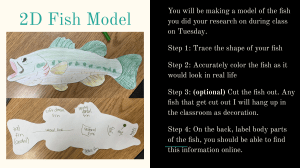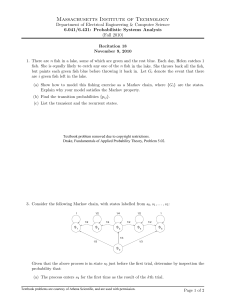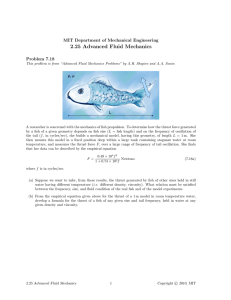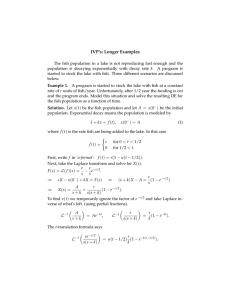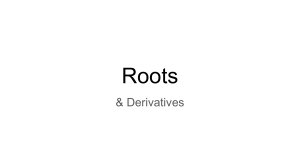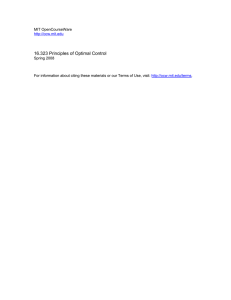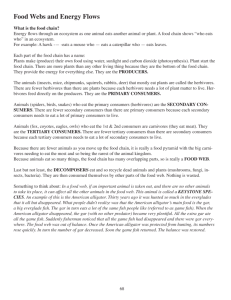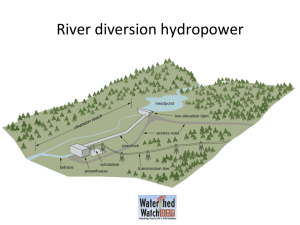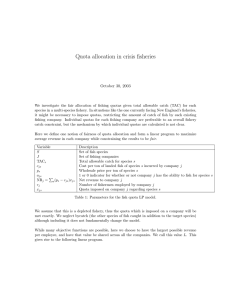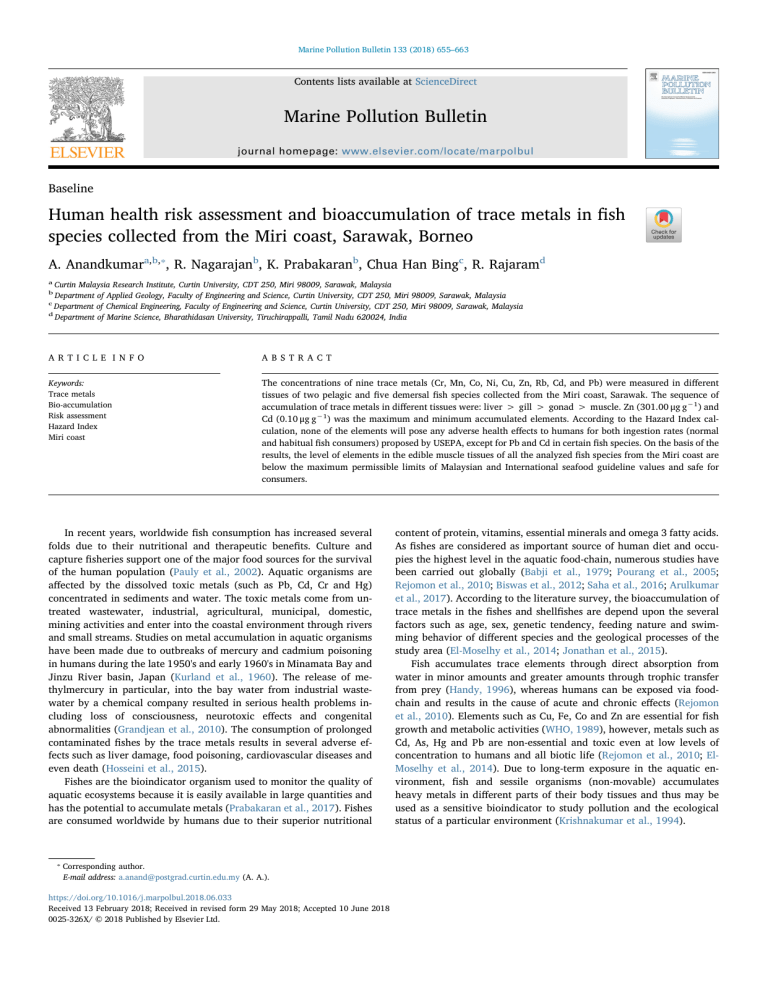
Marine Pollution Bulletin 133 (2018) 655–663 Contents lists available at ScienceDirect Marine Pollution Bulletin journal homepage: www.elsevier.com/locate/marpolbul Baseline Human health risk assessment and bioaccumulation of trace metals in fish species collected from the Miri coast, Sarawak, Borneo T ⁎ A. Anandkumara,b, , R. Nagarajanb, K. Prabakaranb, Chua Han Bingc, R. Rajaramd a Curtin Malaysia Research Institute, Curtin University, CDT 250, Miri 98009, Sarawak, Malaysia Department of Applied Geology, Faculty of Engineering and Science, Curtin University, CDT 250, Miri 98009, Sarawak, Malaysia c Department of Chemical Engineering, Faculty of Engineering and Science, Curtin University, CDT 250, Miri 98009, Sarawak, Malaysia d Department of Marine Science, Bharathidasan University, Tiruchirappalli, Tamil Nadu 620024, India b A R T I C LE I N FO A B S T R A C T Keywords: Trace metals Bio-accumulation Risk assessment Hazard Index Miri coast The concentrations of nine trace metals (Cr, Mn, Co, Ni, Cu, Zn, Rb, Cd, and Pb) were measured in different tissues of two pelagic and five demersal fish species collected from the Miri coast, Sarawak. The sequence of accumulation of trace metals in different tissues were: liver > gill > gonad > muscle. Zn (301.00 μg g−1) and Cd (0.10 μg g−1) was the maximum and minimum accumulated elements. According to the Hazard Index calculation, none of the elements will pose any adverse health effects to humans for both ingestion rates (normal and habitual fish consumers) proposed by USEPA, except for Pb and Cd in certain fish species. On the basis of the results, the level of elements in the edible muscle tissues of all the analyzed fish species from the Miri coast are below the maximum permissible limits of Malaysian and International seafood guideline values and safe for consumers. In recent years, worldwide fish consumption has increased several folds due to their nutritional and therapeutic benefits. Culture and capture fisheries support one of the major food sources for the survival of the human population (Pauly et al., 2002). Aquatic organisms are affected by the dissolved toxic metals (such as Pb, Cd, Cr and Hg) concentrated in sediments and water. The toxic metals come from untreated wastewater, industrial, agricultural, municipal, domestic, mining activities and enter into the coastal environment through rivers and small streams. Studies on metal accumulation in aquatic organisms have been made due to outbreaks of mercury and cadmium poisoning in humans during the late 1950's and early 1960's in Minamata Bay and Jinzu River basin, Japan (Kurland et al., 1960). The release of methylmercury in particular, into the bay water from industrial wastewater by a chemical company resulted in serious health problems including loss of consciousness, neurotoxic effects and congenital abnormalities (Grandjean et al., 2010). The consumption of prolonged contaminated fishes by the trace metals results in several adverse effects such as liver damage, food poisoning, cardiovascular diseases and even death (Hosseini et al., 2015). Fishes are the bioindicator organism used to monitor the quality of aquatic ecosystems because it is easily available in large quantities and has the potential to accumulate metals (Prabakaran et al., 2017). Fishes are consumed worldwide by humans due to their superior nutritional ⁎ Corresponding author. E-mail address: a.anand@postgrad.curtin.edu.my (A. A.). https://doi.org/10.1016/j.marpolbul.2018.06.033 Received 13 February 2018; Received in revised form 29 May 2018; Accepted 10 June 2018 0025-326X/ © 2018 Published by Elsevier Ltd. content of protein, vitamins, essential minerals and omega 3 fatty acids. As fishes are considered as important source of human diet and occupies the highest level in the aquatic food-chain, numerous studies have been carried out globally (Babji et al., 1979; Pourang et al., 2005; Rejomon et al., 2010; Biswas et al., 2012; Saha et al., 2016; Arulkumar et al., 2017). According to the literature survey, the bioaccumulation of trace metals in the fishes and shellfishes are depend upon the several factors such as age, sex, genetic tendency, feeding nature and swimming behavior of different species and the geological processes of the study area (El-Moselhy et al., 2014; Jonathan et al., 2015). Fish accumulates trace elements through direct absorption from water in minor amounts and greater amounts through trophic transfer from prey (Handy, 1996), whereas humans can be exposed via foodchain and results in the cause of acute and chronic effects (Rejomon et al., 2010). Elements such as Cu, Fe, Co and Zn are essential for fish growth and metabolic activities (WHO, 1989), however, metals such as Cd, As, Hg and Pb are non-essential and toxic even at low levels of concentration to humans and all biotic life (Rejomon et al., 2010; ElMoselhy et al., 2014). Due to long-term exposure in the aquatic environment, fish and sessile organisms (non-movable) accumulates heavy metals in different parts of their body tissues and thus may be used as a sensitive bioindicator to study pollution and the ecological status of a particular environment (Krishnakumar et al., 1994). Marine Pollution Bulletin 133 (2018) 655–663 A. A. et al. liver and gonad tissues. All these tissues were dried at 80 °C until a constant weight was obtained or to complete dryness. After drying, the tissue samples were reduced to a powder using an agate mortar and then stored in plastic containers which were placed in the desiccator prior to further analysis. Moisture content for all the analyzed tissue samples was calculated using the difference between the initial weight and dry weight. The concentration of metals in the fish samples are expressed as microgram per gram dry weight (μg/g). The dried and powdered tissue of the fishes were thoroughly homogenized and then subjected to digestion using concentrated nitric acid and hydrogen peroxide (1:1) according to FAO methods (Daziel and Baker, 1983). 1 g of powdered fish samples were weighed in the digestion vessels, then a mixture of 10 ml of conc. HNO3 (65%) and H2O2 (30%) was added to the digestion vessel and kept overnight until various reactions occurred. Then, the digestion vessels were heated on a hot plate to 130 °C until the volume of the mixture reduced to 2–3 ml. After digestion, the samples with clear solutions were allowed to cool, filtered and adjusted to 50 ml in the volumetric flask with distilled water. Finally the digested samples were analyzed in the Flame Atomic Absorption Spectrometer (Perkin Elmer AAnalyst 400 with WinLab 32 Software Version 6.5). All the reagents used were analytical grade and glassware were soaked in 20% nitric acid, left overnight and later rinsed with distilled water. The precision of the analytical performance was validated by measuring the certified standard reference material (TORT-2, National Research Council, Canada). The overall mean recovery rates for trace metals ranged between 87% and 105%, and this was found to be satisfactory with the results of certified values (Anandkumar et al., 2017). A human health risk assessment was conducted according to the United States Environmental Protection Agency (USEPA, 2000) methods. The level of exposure resulting from oral human consumption of particular trace metals in the fish edible tissues is expressed by calculating the average daily dose (ADD; average daily intake of a specific chemical over a lifetime) has been calculated using the following equation Miri is the second largest city and it is located in the East Malaysia (Sarawak), in the Island of Borneo. It is the gateway to northern Sarawak and also close to the neighboring country of Brunei. Miri city was the first city in Malaysia to develop a petroleum industry and played a significant role in Miri's initial economic development. During last three decades, industrial development has increased four-fold and has contaminated the land and marine environment in this region either directly or indirectly (Lau et al., 1996). Miri city is the hub of major industrial activities on the banks of the two major rivers (Baram and Miri) which runs through the city and directly empties into the South China Sea (Anandkumar et al., 2017). Development in the coastal zone has been particularly rapid in the last several years due to the discovery of oil fields. The city is dotted by numerous palm oil production industries, timber processing and automobile workshops. There is also number of ship building industries in Miri, with many of them having their base in Kuala Baram, Piasau or Krokop suburbs (Nagarajan et al., 2014). Miri city is rapidly becoming one of Sarawak's most popular tourist destinations and is often marketed as “Resort city” and is a popular destination for seafood restaurants. Previous studies, carried out by Nagarajan et al. (2013) and Billah et al. (2016) in this region have highlighted that the beaches in this region are exposed to several types of pollution sources including both natural and anthropogenic sources. The geological basement of Miri is dominated by the Miri Formation which consists of deltaic cycles of layered clay-sand sequence. Miri Formation is divided into Upper and Lower Formations, which consists of marine sandstone and shale alternations. The formation in this part of the region is predominantly of shale inter-bedded with sandstones of arenaceous clay and shale (King et al., 2010; Nagarajan et al., 2014). The alluvial coastal plain is observed along the shoreline of Miri coast and the alluvium formation can be seen on the banks of the rivers (Anandkumar, 2016). In Miri, trace metal pollution studies in the water and sediments has received much attention from the researchers (Nagarajan et al., 2013; Billah et al., 2016). However, to the best of our knowledge, existing studies have not studied the bioaccumulation of metal concentration in the commercially important fishes from the Miri coast. The present study aiming to evaluate the concentration of trace metals in different organs of the fishes and compared against the recommended maximum permissible limit (MPL) to better understand the possible ecotoxicological human health risk associated in consumption of these fishes from the Miri coast. In this study, seven commercially important fresh fish species were collected from the fish landing center located on the Miri coast (Latitude 4°29′38.72″N and Longitude 113°59′46.19″E) Sarawak, East Malaysia (Fig. 1). The collected fish species were Carcharhinus leucas, Scomberomorus lineolatus, Sphyraena qenie, Setipinna tenuifilis, Psettodes erumei and Trichiurus lepturus. The selection of fish species was based on the most commonly consumed and economically important seafood of the local population. Fishes were classified as either pelagic or demersal. Demersal species feed mostly on the sea floor, whereas pelagic species mainly feed in the water column. Among the collected fish species, Scomberomorus lineolatus and Setipinna tenuifilis belong to the pelagic habitat and the rest of the fish species (Carcharhinus leucas, Sphyraena qenie, Psettodes erumei, Trichiurus lepturus and Otolithes ruber) are demersal habitat occupants. From each species, a minimum of 10 specimens were collected from the fish landing center. Collected fish samples were packed in polyethylene bags, labeled, place in an ice box and transferred to the laboratory for further analysis. After reaching the laboratory, the collected fish species were identified using taxonomy texts and the fishbase.org website. The average length, weight, scientific name, English/common name, habitat, and the feeding habits of the collected fish species were recorded and reported in Table 1. After recording the respective sizes, the fish samples were thawed to room temperature then washed with double distilled water. The fish samples were dissected and separated the muscle, gills, ADD (mg / kg / day ) = Cm∗IR∗EF ∗ED BW ∗AT where, Cm is the mean concentration of element/metal in fish muscle (mg/kg dry wt.), IR is the rate of ingestion (0.0312 kg/day for normal and 0.1424 kg/day for habitual fish consumers), EF is the exposure frequency (365 days/year), ED is the exposure duration over a lifetime (assumed as 70 years), BW is the body weight (assumed as 70 kg for normal adults), and AT is the average lifetime (70 years × 365 days/ year). Risk assessment was assessed by calculating the Hazard Index (HI), which is a non-cancer index of adverse health effects from intake of specific trace metal contaminant in food. HI is expressed as the ratio of the ADD to the oral reference dose (RfD) of the trace metal according to the following equation (USEPA, 2000). Hazard Index = ADD Oral RfD where oral RfD is the oral reference dose of trace metals (mg/kg/days) based on the safe upper level of elements oral intake for an adult human with an average body weight of 70 kg. The oral RfD for Cu, Pb, Zn, Mn, Cd, Ni and Cr is 0.04, 0.00357, 0.3, 0.14, 0.001, 0.02 and 1.5 mg/kg/ day, respectively (USEPA, 2015), while for Co is 0.03 mg/kg/day (Finley et al., 2012). HI values < 1.0 indicate adverse health effects are not likely to occur. However, if the ADD of certain trace metal exceeds its oral RfD and thus the HI > 1.0, it may be presumed that adverse health effects are expected to occur. In this study, the most commonly consumed and commercially important fish samples were obtained from the fish landing center located at the Satu Batu area near Kampong Kualabaram, Miri coast and then analyzed for the accumulation of trace elements in their different organ tissues. Seven species of fish (Carcharhinus leucas, Scomberomorus 656 Marine Pollution Bulletin 133 (2018) 655–663 A. A. et al. Fig. 1. Study area showing the fish landing centers. Table 1 Morphometric measures of the fish species collected from the Miri coast. Fish species English/common name Length (cm) Weight (g) Habitat Feeding nature Climate Carcharhinus leucas Bull Sharks 56.4 930.2 Semi-pelagic Tropical & Subtropical Scomberomorus lineolatus Sphyraena qenie Spanish Mackerel Barracuda 27.2 29.5 166.8 280.5 Setipinna tenuifilis Common hairfin anchovy Indian Halibut 14.6 23.6 Pelagic-neritic Pelagic-Demersal - Reefassociated Pelagic-neritic 22.9 146.9 Pelagic-Demersal Large head hairtail/ Ribbon fish Tiger tooth croaker 36.8 79.1 Bentho-pelagic 18.6 75.9 Bentho-pelagic Carnivorous (feeds on bony fishes, crabs, shrimps, sea snails, rays etc.) Carnivorous (feeds on fishes) Carnivorous (feeds on snappers, groupers, small tunas and anchovies) Carnivorous (feeds on prawn, copepods, crustacean larvae, mollusks and fishes) Carnivorous (feeds on small fish and benthic invertebrates) Carnivorous (feed mainly on fishes and occasionally on squids and crustaceans) Carnivorous (feeds on fishes, prawns and other invertebrates) Psettodes erumei Trichiurus lepturus Otolithes ruber 657 Marine Pollution Bulletin 133 (2018) 655–663 A. A. et al. Table 2 Concentration of trace elements (μg g−1 dry weight) in various organs of the fish species collected from the Miri coast. Biota Organs Cr Mn Co Ni Cu Zn Rb Cd Pb Carcharhinus leucas Muscle Gill Liver Gonad Muscle Gill Liver Gonad Muscle Gill Liver Gonad Muscle Gill Liver Gonad Muscle Gill Liver Gonad Muscle Gill Liver Gonad Muscle Gill Liver Gonad 4.6 7.3 4.4 8.0 4.5 6.6 4.5 2.4 1.2 5.8 1.9 2.45 NA NA NA NA NA NA NA NA NA NA NA NA NA NA NA NA 0.4 9.1 5.9 7.5 0.7 20 4.5 6.6 1.0 15.4 7.0 5.3 3.6 73.0 NA 4.7 3.8 32.7 6.3 4.15 3.4 10.9 NA NA 1.55 NA NA 5.75 6.5 8.1 6.2 9.2 0.8 2.2 0.9 0.7 0.1 2.9 0.04 0.2 NA NA NA NA NA NA NA NA NA NA NA NA NA NA NA NA 4.1 13.6 2.3 4.3 1.2 2.2 1.0 1.3 0.8 4.5 1.3 2.2 NA NA NA NA NA NA NA NA NA NA NA NA NA NA NA NA 13.3 16.4 27.5 23.1 8.5 17.0 16.4 16.9 8.7 12.9 65.5 15.9 9.9 8.8 NA 13.3 9.0 14.3 36.9 14.83 9.0 13.0 NA NA 12.4 NA NA 22.75 71.0 153.0 84.0 200 20.2 86.5 102 27.3 43.0 137.5 301.0 160.0 36.6 73.0 NA 79.2 17.3 126.4 160.8 77.4 25.3 29.4 NA NA 16.9 NA NA 79.2 9.5 6.7 1.8 7.0 2.9 0.6 2.0 2.5 3.4 1.7 1.9 2.4 NA NA NA NA NA NA NA NA NA NA NA NA NA NA NA NA 0.6 0.6 0.5 2.7 0.2 0.6 3.4 2.4 0.3 0.1 4.5 1.4 0.4 0.8 NA 0.6 0.7 0.9 2.8 0.51 0.6 0.35 NA NA 0.3 NA NA 0.7 2.4 4.2 20.0 3.1 1.7 5.7 1.3 1.8 1.9 9.8 1.0 2.2 2.6 6.7 NA 1.2 1.7 11.9 0.8 0.5 0.6 2.05 NA NA 1.6 NA NA 4.25 Scomberomorus lineolatus Sphyraena qenie Setipinna tenuifilis Psettodes erumei Trichiurus lepturus Otolithes ruber NA-Not analyzed. East coast of India (2.90 μg g−1), Kumar et al. (2012); Bay of Bengal, Bangladesh (3.63 to 17.80 μg g−1), Saha et al. (2016), but higher than values reported from the Black Sea (0.56–0.69 μg g−1), Topcuoğlu et al. (2002). The Co concentration in the analyzed fish organs varied from 0.04 to a maximum of 9.20 μg g−1. Among the species and the organs analyzed, the maximum concentration was recorded in the gonads of Carcharhinus leucas as 9.20 μg g−1 and the lowest concentration was detected in the muscle of Sphyraena qenie as 0.1 μg g−1. In the analyzed fish species, a higher Co accumulation was noticed in the gills followed by the gonads, liver and muscle Table 2. The Co concentration in the analyzed fish muscle was found in the order of Carcharhinus leucas > Scomberomorus lineolatus > Sphyraena qenie. The concentration of Co in fish muscles varied between below 0.1 and 6.50 μg g−1 with an average of 2.33 μg g−1. The observed values of Co in fish tissues were higher than the values reported from Gulf of Cambay, India (0.24 μg g−1), Reddy et al. (2007); Black Sea coast (0.05–0.40 μg g−1), Topcuoğlu et al. (2002); Iran (0.61 to 0.91 μg g−1), Hosseini et al. (2015) but lower than the values reported from the southwest coast of India (3.64–11.80 μg g−1), Rejomon et al. (2010). The Ni concentration in the fish organs varied between 0.85 and 13.6 μg g−1, with an average of 3.24 μg g−1. Among the species and the organ tissues measured, the maximum and minimum Ni content was observed in the gills of Carcharhinus leucas and the muscles of Sphyraena qenie as 13.6 μg g−1 and 0.85 μg g−1 respectively. The concentration of Ni in fish muscles varied between 0.85 and 4.10 μg g−1 with an average value of 2.06 μg g−1. The Ni concentration was more abundant in the gills followed by the gonads, liver and muscle (Table 2). In the fish muscles the order of concentration was (highest to lowest) Carcharhinus leucas > Scomberomorus lineolatus > Sphyraena qenie. The observed values of Ni (0.85–4.10 μg g−1) in fish muscles was higher than those observed from Masan Bay, Korea (0.00–0.03 μg g−1), Kwon and Lee (2001) but lower than the values reported for Ni from the Mediterranean Sea (4.25–6.07 μg g−1), Kalay et al. (1999); southwest coast of India (6.06–13.92 μg g−1), Rejomon et al. (2010) and Iran (49.40–54.10 μg g−1), Hosseini et al. (2015). lineolatus, Sphyraena qenie, Setipinna tenuifilis, Psettodes erumei, Trichiurus lepturus and Otolithes ruber) were obtained and used to determine the trace metals (Cr, Mn, Co, Ni, Cu, Zn, Rb, Cd, and Pb) concentrations in their body organs. Cu, Pb, Cd, Mn and Zn were analyzed in four different organs (namely muscle, gill, liver and gonad) of the fish except in the case of only (the gills of Otolithes ruber, the gonads of Trichiurus lepturus and the liver of Trichiurus lepturus, Otolithes ruber and Setipinna tenuifilis). Co, Ni, Rb and Cr were analyzed in three species (Carcharhinus leucas, Scomberomorus lineolatus and Sphyraena qenie) of fish organs. The concentration of trace/heavy metals in the studied fish species and their organs are reported in Table 2. Results showed that, the Cr concentrations in fish organs varied from 1.20 to 8.01 μg g−1. Among the species and the organ tissues, the highest Cr level was recorded in the gonad tissue of Carcharhinus leucas (8.01 μg g−1) and the lowest value was observed in the muscle tissues of Sphyraena qenie (1.20 μg g−1). The chromium accumulation in various organs of the fishes was not similar with previous reports (Table 3). Chromium concentration in fish muscles was in the order Carcharhinus leucas > Scomberomorus lineolatus > Sphyraena qenie. In these species, Cr concentration in the muscles varied from 1.20 to 4.60 μg g−1 with an average of 3.45 μg g−1. These values were higher compared to those reported in similar studies from other locations. For example: the Mediterranean Sea, (1.28–1.60 μg g−1), Kalay et al. (1999); the Turkish Sea, (0.03–2.08 μg g−1), Ateş et al. (2015); the Masan Bay, Korea (0.02–0.05 μg g−1), Kwon and Lee (2001) and Black sea (0.06–0.84 μg g−1), Topcuoğlu et al. (2002). The Mn concentration in the analyzed fish organs varied between 0.40 (muscle of Carcharhinus leucas) and 73.01 μg g−1 (gills of Setipinna tenuifilis). In all the fish species, Mn concentration was high in gills followed by gonads, liver and muscle (Table 2). The Mn concentration in the analyzed fish muscles was in the order of Psettodes erumei > Setipinna tenuifilis > Trichiurus lepturus > Otolithes ruber > Sphyraena qenie > Scomberomorus lineolatus > Carcharhinus leucas. For these species, the average Mn in the muscles was 2.06 μg g−1; which was lower compared to the values reported from the Langkawi Islands, Malaysia (16.80 to 24.35 μg g−1), Irwandi and Farida (2009); 658 Marine Pollution Bulletin 133 (2018) 655–663 A. A. et al. Table 3 Comparison of trace metals concentration in muscle tissues (μg g−1 dry weight) of commercially important fishes with values taken from open literature. Study area Trace metals References Mn Cu Cr Pb Cd Zn Co Ni Rb Peninsular Malaysia Bay of Bengal Mediterranean Sea Masan Bay, Korea – 5.00–11.14 – – – 3.33–4.68 3.40–5.88 0.18–0.84 – – 1.28–1.60 0.02–0.09 0.21–0.32 1.67–2.58 7.33–9.11 0.04–0.15 0.03–0.05 0.01–0.16 1.07–1.43 0.00–0.03 2.3–6.5 18.86–33.89 16.1–31.4 6.33–12.86 – – – – 6.43–7.57 4.25–6.07 0.00–0.03 – 3.28–27.85 – – Black Sea 0.69–3.56 1.01–4.54 < 0.06–0.84 < 0.05–0.60 < 0.02–0.24 25.7–44.2 < 0.05–0.40 < 0.01–2.04 – Caspian Sea, 0.32–0.56 1.22–1.91 0.31–0.40 0.004–0.037 0.001–0.006 17.95–24.47 0.002–0.009 Langkawi, Malaysia 24.35 0.01 – 1.1 0.9 49.39 – – – SW coast, India – 2.06–3.62 – 0.23–0.56 1.25–6.38 24.4–84.30 3.64–11.8 6.06–13.92 – Santa Maria Bay, Mexico Palk Bay, India 0.105 0.059 0.175 0.086 0.021 1.161 0.057 0.197 – – 0.90–8.68 – 0.1–0.12 0.02–0.28 18.80–55.14 – – – 0.07–3.62 3.63–17.80 0.16–10.7 0.60–8.54 0.03–2.08 1.27–4.66 0.15–1.15 0.80–6.23 0.01–0.43 0.02–0.47 4.17–22.4 13.22–74.36 0.01–0.41 0.21–0.56 0.01–3.43 1.88–7.56 – – Babji et al. (1979) Sharif et al. (1991) Kalay et al. (1999) Kwon and Lee (2001) Topcuoğlu et al. (2002) Pourang et al. (2005) Irwandi and Farida (2009) Rejomon et al. (2010) Jonathan et al., 2015 Arulkumar et al. (2017) Ateş et al. (2015) Saha et al. (2016) 0.4 0.7 13.3 8.5 4.6 4.55 2.4 1.75 0.6 0.2 71 20.25 6.5 0.8 4.1 1.25 9.5 2.9 Present study Present study 1 3.8 3.4 1.55 3.6 8.7 9 9 12 9.9 1.2 – – – – 1.95 1.75 0.6 1.6 2.6 0.35 0.7 0.6 0.3 0.4 43 17.3 25.35 16.9 36.65 0.1 – – – – 0.85 – – – – 3.45 – – – – Present Present Present Present Present Turkish Sea Bay of Bengal, Bangladesh Carcharhinus leucas Scomberomorus lineolatus Sphyraena qenie Psettodes erumei Trichiurus lepturus Otolithes ruber Setipinna tenuifilis 2.21–3.12 study study study study study average values reported from the Gulf of Cambay, India (38.54 μg g−1), Reddy et al. (2007) but higher than the values reported from Peninsular Malaysia (2.30–6.50 μg g−1), Babji et al. (1979). However, the observed average Zn in the fish muscles along the Miri coast was lower than the values reported for Zn in the marine fishes from Langkawi Island, Malaysia (49.39 μg g−1), Irwandi and Farida (2009); Poompuhar coast, India (156.78 μg g−1), Prasath and Khan (2008); Bay of Bengal, Bangladesh (13.22 to 74.36 μg g−1), Saha et al. (2016) and Palk Bay, India (18.80 to 55.14 μg g−1) Arulkumar et al. (2017). The Rb concentration in the analyzed fish organs varied between 0.65 and 9.50 μg g−1. Among the species and the organs, the maximum concentration was recorded in the muscle of Carcharhinus leucas (9.50 μg g−1), and the lowest value was in the gills of Scomberomorus lineolatus (0.65 μg g−1). The Rb accumulation was high in muscle, followed by the gonad, liver and gill Table 2. The Rb concentration in the muscle was in the order (highest–lowest); Carcharhinus leucas > Sphyraena qenie > Scomberomorus lineolatus. In Scomberomorus lineolatus and Sphyraena qenie the accumulation pattern is in the same order as muscle > gonad > liver > gill. The concentration of Rb in fish muscle varied between 0.65 and 9.50 μg g−1 with an average value of 5.28 μg g−1. These values were higher than the values reported for the muscles of five sturgeon species from the Caspian Sea (2.21 to 3.12 μg g−1), Pourang et al. (2005); and the Jamaican coast (0.61 to 1.03 μg g−1), Hoo Fung et al. (2013) but lower than the values reported from the Bay of Bengal, Bangladesh (3.28 to 27.85 μg g−1), Sharif et al. (1991). The Cd concentration in the fish organs varied between 0.10 and 4.50 μg g−1 with an average of 1.17 μg g−1. Among the species and the organs studied, the liver of Sphyraena qenie showed the highest concentration (at 4.50 μg g−1) with the lowest concentration detected in the muscle of Sphyraena qenie (at 0.10 μg g−1). The Cd accumulation sequence was same for Scomberomorus lineolatus and Sphyraena qenie with liver > gonad > gill > muscles. This differed for Carcharhinus leucas, which showed a sequence as; gonad > liver > gill > muscle Table 2. The Cd concentration in the fish muscles was in the following The Cu concentration in fish muscles varied between 8.50 and 13.30 μg g−1. Among the species and the organ tissues, the liver of Sphyraena qenie had the highest concentration (65.50 μg g−1) and the lowest concentration was observed in the muscle of Scomberomorus lineolatus (8.50 μg g−1). In the fish species; (Carcharhinus leucas, Sphyraena qenie and Psettodes erumei) the accumulation of Cu showed the same sequence as liver > gonads > gills > muscles. The sequence of Cu concentration in all organs of the fish species is listed in Table 2. The Cu concentration in the fish muscles was in the order (highest to lowest) Carcharhinus leucas > Otolithes ruber > Setipinna tenuifilis > Trichiurus lepturus > Psettodes erumei > Sphyraena qenie > Scomberomorus lineolatus. The Cu concentration in the fish muscles was higher than the values reported for the marine fish from, the Mediterranean Sea (3.40–5.88 μg g−1), Kalay et al. (1999); the Turkish Sea, (0.16–10.70 μg g−1), Ateş et al. (2015); Palk Bay, India (0.90 to 8.68 μg g−1), Arulkumar et al. (2017) but lower than the values reported from Poompuhar, SE coast of India (20.48 μg g−1), Prasath and Khan (2008); Langkawi Island, Malaysia (11.48 to 13.95 μg g−1), Irwandi and Farida (2009). The Zinc concentration was the highest compared to all elements analyzed in the different species of fishes. Its concentration in the different species of fish organs showed wide fluctuations, ranging from 16.90 to 301.00 μg g−1. Among the species and the organs, the Sphyraena qenie liver had the highest concentration of Zn, and the lowest value was observed in the muscle of Otolithes ruber. The accumulation sequence of Zn in all the organs of the fish species is shown in Table 2 with a sequence of liver > gill > gonad > muscles, the same pattern in as Scomberomorus lineolatus and Psettodes erumei. The liver and gonads are the main target organs which accumulate higher Zn concentration compared to gills and muscle. The Zn concentration in the analyzed fish muscles was recorded in the order of (highest to lowest) Carcharhinus leucas > Sphyraena qenie > Setipinna tenuifilis > Trichiurus lepturus > Scomberomorus lineolatus > Psettodes erumei > Otolithes ruber. The mean Zn concentration in the muscle tissues of fish species was 32.92 μg g−1, which was similar to the 659 Marine Pollution Bulletin 133 (2018) 655–663 A. A. et al. is dependent on bioaccumulation, physiology and the feeding habits of the fish (Canli and Atli, 2003). Elements choose their body part (organs) depending on their metabolic activity. Among the different organs of fish, the liver acts as a primary organ for metal storage (Roesijadi, 1996; Amiard et al., 2006). The liver plays an important role in the metabolic processes of trace metals in fish and is related to the natural binding of metallothioneins (MT) proteins (Görür et al., 2012). In this case, the liver accumulates more metals than the muscle since it has higher metabolic activity, and it also has a specific function of accumulating and transporting metals in the body. The liver also plays an important role in detoxification (Staniskiene et al., 2006). Zinc and Cu are essential for the normal growth of aquatic organisms and their enzymatic reactions (Handy, 1996). A higher accumulation of Cu and Zn in the liver indicates these elements have a role in cellular metabolism, whereas Zn is required for bile secretion (Roesijadi, 1996). The Cu and Zn in the liver are necessary in order to fulfill enzymatic and other metabolic demands in organisms together with MT protein (Amiard et al., 2006). The higher concentration of nonessential elements such as Cd was present in the liver tissues of Scomberomorus lineolatus, Sphyraena qenie and Psettodes erumei as well as Pb in the liver tissues of Carcharhinus leucas. The presence of MT proteins in the hepatic tissue has a greater tendency to bind with Cu, Zn and Cd. Most of the studies (Irwandi and Farida, 2009; El-Moselhy et al., 2014; Ahmed et al., 2016) reported the accumulation of essential and nonessential metals have occurred more often in the liver followed by the gills, gonads and muscle. The concentration of metals in the surrounding water is reflected by the gills because the gills have direct contact with the water and suspended materials therein during the respiration process (Yilmaz, 2003). Due to the process of osmoregulation and gas exchange, the gills act as a barrier to the metal ion exchange from water (Ahmed et al., 2016). Therefore, it is clear that metals stored in the gill tissues are gathered mainly from the surrounding water of a particular environment. In addition, the size of the gills in different fish species also controls the level of metal accumulation and levels of metal are higher in larger gilled organisms. Higher concentrations of Pb and Mn accumulate in the gills, as compared to the other organs. Apart from Carcharhinus leucas, the other fish species Scomberomorus lineolatus, Sphyraena qenie, Setipinna tenuifilis, Psettodes erumei and Trichiurus lepturus had the highest concentration of Pb and Mn in their gills. Similar results of higher accumulation of Pb and Mn in the gill tissues were recorded by several authors (Ismail and Abu-Hilal, 2008; El-Moselhy et al., 2014). An increase in the Pb and Mn concentration in the water column was due to the diffusion of dissolved/particulate forms of Mn and Pb from several sources such as atmospheric deposition, river runoff and small stream discharges from industrial and plantation sites which then mixes directly with the water and settles to the sea bottom mixing with the original sediments because of oxidative precipitation, where it again re-dissolves due to the reducing condition in the sediments and the high water energy flow from the freshwater contribution (Nagarajan et al., 2013; Anandkumar, 2016; Anandkumar et al., 2017). So this is the reason for the enrichment of Mn and Pb along the coast of the study area. A large amount of oxide surfaces for metals in the water column are produced due to the rapid cycling of Mn between the oxidative precipitation and reductive dissolution cycles. These oxide surfaces have a high scavenging affinity for manganese oxide surfaces such as Pb. It is essential to know the fish consumption information for assessing the human health effects along with the chemically contaminated fish. The Hazard Index (HI) is a combined risk calculation package that groups both the metal level in fish edible muscles and the consumption rate of these muscles by a human to achieve a hazard classification. The ingestion rates of mean normal and habitual consumers used in this study have been proposed by the USEPA (2015) for the general human population. Results of HI values calculated for the various metals in muscle tissues of fish species in this study is presented in Table 5 and decreasing order of; Psettodes erumei > Carcharhinus leucas > Trichiurus lepturus > Setipinna tenuifilis > Sphyraena qenie > Otolithes ruber > Scomberomorus lineolatus. The mean Cd content for the muscles is 0.45 μg g−1, which was similar to the values reported from the NE coast of India (0.41 μg g−1), Kumar et al. (2012) but lower than the value reported from the coastal fish of Langkawi Island, Malaysia (0.20 to 0.90 μg g−1), Irwandi and Farida (2009) and the NE Mediterranean Sea (1.07 to 1.43 μg g−1), Kalay et al. (1999). However, the average values of Cd in this study exceeded the values reported for fish from Peninsular Malaysia (0.03–0.05 μg g−1), Babji et al. (1979); Bay of Bengal, Bangladesh (0.02 to 0.47 μg g−1) Saha et al. (2016) and Palk bay, India (0.02 to 0.28 μg g−1), Arulkumar et al. (2017). The Pb concentration in the fish organs varied between 0.57 and 20 μg g−1 with an average value of 3.89 μg g−1. Among the species and the organs, the highest and lowest concentration of Pb was detected in the liver of Carcharhinus leucas (20.00 μg g−1), and the gonads of Psettodes erumei (0.57 μg g−1) respectively. In most of the fish species, the Pb accumulation (Table 2) was high in the gills followed by liver, gonad and muscle with the exception of Carcharhinus leucas and Sphyraena qenie, which showed the highest concentration in the liver. In the case of Otolithes ruber, the highest accumulation was in the gonads, followed by muscle. The Pb concentration in the fish muscle was in the following decreasing order; Setipinna tenuifilis > Carcharhinus leucas > Sphyraena qenie > Psettodes erumei > Scomberomorus lineolatus > Otolithes ruber > Trichiurus lepturus. The concentration of Pb in fish muscle varied between 0.60 and 2.60 μg g−1 with an average of 1.81 μg g−1. These values were higher than those observed for the coastal fish from Peninsular Malaysia (0.21–0.32 μg g−1), Babji et al. (1979); Langkawi Islands, Malaysia (0.80 to 1.00 μg g−1), Irwandi and Farida (2009) and Palk Bay, India (0.1 to 0.12 μg g−1), Arulkumar et al. (2017) but lower than those values for the coastal fish from the Red Sea (4.80 μg g−1), Ismail and Abu-Hilal (2008) and Bay of Bengal, Bangladesh (0.80 to 6.23 μg g−1), Saha et al. (2016). The values obtained in this study were comparable with those found on the edible fishes from the coastal region of Kalpakkam, India (0.40–2.29 μg g−1), Biswas et al. (2012). In the present study, the accumulation of trace metals in the tissue organs of demersal fish (Carcharhinus leucas, Sphyraena qenie, Psettodes erumei, Trichiurus lepturus and Otolithes ruber) was higher than pelagic fishes (Scomberomorus lineolatus and Setipinna tenuifilis). This is due to the direct contact with element enriched seafloor sediments, feeding mechanisms and the greater uptake of trace metal from zoobenthic predators and metal interaction with benthic organisms. Metal absorption in aquatic organisms was facilitated by two routes: the digestive tract (dietary exposure via the food-chain) and through the gill surface by waterborne exposure (Ptashynski et al., 2002). The concentrations of trace metals in the fish species studied were in the ranges of Cu, 8.50 to 65.50 μg g−1; Pb, 0.57 to 20.00 μg g−1; Cd, 0.10 to 4.50 μg g−1; Mn, 0.40 to 32.75 μg g−1; Co, 0.10 to 9.20 μg g−1; Ni, 0.85 to 13.60 μg g−1; Rb, 0.65 to 9.50 μg g−1; Zn, 16.90 to 301.00 μg g−1; and Cr, 1.20 to 7.30 μg g−1. The order of trace metal accumulation in the different organs of fish species is shown in Table 4. The minimum values were observed in the muscles for Cu, Pb, Cd, Mn, Co, Ni, Zn and Cr with the exception of Rb, which was observed in the gills while the maximum values were recorded in the livers for Cu, Cd and Zn, and in the gills for Mn, Cr, Co, Ni and Pb. Zinc and Cu are essential elements for normal metabolic activities, so their accumulation was found to be higher in all the organs of the analyzed fish species. Carcharhinus leucas alone showed the maximum concentration of Co in the gonads and Pb in the liver, which was consistent with findings from the Red Sea, Egypt (El-Moselhy et al., 2014). From the results, it was clearly observed that most of the analyzed elements accumulated in the liver followed by the gills, gonads and muscle. The essential elements Zn and Cu were higher in all the analyzed organs of fish in this study. The metal absorption rate varied between the body parts of the fish (muscles, liver, gills and gonads) and 660 Marine Pollution Bulletin 133 (2018) 655–663 A. A. et al. Table 4 Trace metal accumulation in different organs of the analyzed fish species. Species Tissue Order Carcharhinus leucas Muscle Gill Liver Gonad Muscle Gill Liver Gonad Muscle Gill Liver Gonad Muscle Gill Gonad Muscle Gill Liver Gonad Muscle Gill Muscle Gonad Zn Zn Zn Zn Zn Zn Zn Zn Zn Zn Zn Zn Zn Zn Zn Zn Zn Zn Zn Zn Zn Zn Zn Scomberomorus lineolatus Sphyraena qenie Setipinna tenuifilis Psettodes erumei Trichiurus lepturus Otolithes ruber Table 6. The calculated HI values for all fish muscles are < 1 for all the studied trace metals, indicating humans would not experience any significant health risk at both ingestion rates by consumers except for Pb in Carcharhinus leucas, Sphyraena qenie and Setipinna tenuifilis and for Cd in Carcharhinus leucas, Psettodes erumei and Trichiurus lepturus for habitual fish consumers. Among the trace metals examined in this study, Pb and Cd in certain fish species (Table 6) showed the highest value of HI (1 >) which may cause chronic effects in humans when these fishes are consumed at a greater quantity. Among the analyzed metals, Pb and Cd are classified as non-essential toxic metals, which cause health hazards. Various agencies such as the FAO (1983); the WHO (1989); the EC (2014) and FSSAI (2015) prescribed maximum residual limits for human consumption. The food standards for fish set by the FAO (1983) and the WHO (1989) are in wet weight based-concentrations (Table 7). For comparing with food standards, the metal concentrations in the tissues of aquatic organisms in this study (Table 2), needed to be converted into wet weight by dividing them by factors ranging from 4 to 6 (Rejomon et al., 2010; Anandkumar et al., 2017). In this study, overall a factor 4.54 (i.e. 78% moisture) was adopted. By using this factor, the derived wet weight based concentrations of Cu, Cd, Pb, Ni, Cr, Mn and Cr in the muscles of analyzed fish species from the Miri coast fell below the maximum permissible limits (MPLs) of the WHO (1989), the FAO (1983), EC (2014) and FSSAI (2015). Unfortunately, the safe level for Co in fish is not defined (Saha et al., 2016). From these results, the examined fish species were not associated with chemical hazards in their muscles and are safe for > > > > > > > > > > > > > > > > > > > > > > > Cu > Rb > Co > Cr > Ni > Pb > Cd > Mn Cu > Ni > Mn > Co > Cr > Rb > Pb > Cd Cu > Pb > Co > Mn > Cr > Ni > Rb > Cd Cu > Co > Cr > Mn > Rb > Ni > Pb > Cd Cu > Cr > Rb > Pb > Ni > Co > Mn > Cd Mn > Cu > Cr > Pb > Ni > Co > Rb > Cd Cu > Mn > Cr > Cd > Rb > Pb > Ni > Co Cu > Mn > Rb > Cr > Cd > Pb > Ni > Co Cu > Rb > Pb > Cr > Mn > Ni > Cd > Co Mn > Cu > Pb > Cr > Ni > Co > Rb > Cd Cu > Mn > Cd > Rb > Cr > Ni > Pb > Co Cu > Mn > Cr > Rb > Pb > Ni > Cd > Co Cu > Mn > Pb > Cd Mn > Cu > Pb > Cd Cu > Mn > Pb > Cd Cu > Mn > Pb > Cd Mn > Cu > Pb > Cd Cu > Mn > Cd > Pb Cu > Mn > Pb > Cd Cu > Mn > Pb > Cd Cu > Mn > Pb > Cd Cu > Pb > Mn > Cd Cu > Mn > Pb > Cd Table 6 Indicating HI for muscle consumption calculated at mean ingestion and subsistence rates for Co, Ni and Cr in three fish species. Fish Sp Coa Cob Nia Nib Cra Crb Carcharhinus leucas Scomberomorus lineolatus Sphyraena qenie 0.120 0.033 0.044 0.549 0.149 0.200 0.091 0.028 0.019 0.417 0.127 0.086 0.001 0.001 0.000 0.006 0.006 0.002 a b 0.0312 kg/day (mean ingestion rate). (0.1424 kg/day (subsistence ingestion rate)). Table 7 Maximum Permissible Limit (MPL) of trace/heavy metals in fish muscles (μg g−1 wet weight) according to National and International Guidelines values. Standard's Cu Cr Pb Cd Zn Ni Mn WHO (1989) MFR (1985) FAO (1983) USEPA (2000) EC (2014) FSSAI (2015) 30 30 30 120 – – 50 – – 8 – 2 2 0.5 4 0.3 0.3 1 1 0.5 2 0.5 0.3 100 100 40 120 30 – 0.5–1 – – – – – 1 – – – – – WHO-World Health Organization; MFR-Malaysian Food Regulation; FAO-Food and Agricultural Organization; USEPA-United States Environmental Protection Agency; EC-European Commission; FSSAI-Food, Safety Standards Authority of India. Table 5 Indicating HI for muscle consumption calculated at mean ingestion and subsistence rates for Cu, Pb, Zn, Mn and Cd for seven fish species. Fish Sp Cua Cub Pba Pbb Zna Znb Mna Mnb Cda Cdb Carcharhinus leucas Scomberomorus lineolatus Sphyraena qenie Psettodes erumei Trichiurus lepturus Otolithes ruber Setipinna tenuifilis 0.148 0.095 0.097 0.100 0.100 0.134 0.110 0.676 0.432 0.442 0.458 0.458 0.610 0.503 0.300 0.218 0.243 0.218 0.075 0.200 0.325 1.368c 0.997 1.111c 0.997 0.342 0.912 1.482c 0.105 0.030 0.064 0.026 0.038 0.025 0.054 0.481 0.137 0.292 0.117 0.172 0.115 0.249 0.001 0.002 0.003 0.012 0.011 0.005 0.011 0.006 0.010 0.015 0.055 0.049 0.023 0.052 0.267 0.089 0.156 0.312 0.267 0.134 0.178 1.221c 0.407 0.712 1.424c 1.221c 0.610 0.814 a b c 0.0312 kg/day (mean ingestion rate). (0.1424 kg/day (subsistence ingestion rate)). HI > 1, adverse health effects are expected to occur (bold letters). 661 Marine Pollution Bulletin 133 (2018) 655–663 A. A. et al. specific metal characterization of selected fish species in Pakistan. Environ. Monit. Assess. 188 (4), 1–9. http://dx.doi.org/10.1007/s10661-015-4999-z. Amiard, J.C., Amiard-Triquet, C., Barka, S., Pellerin, J., Rainbow, P.S., 2006. Metallothioneins in aquatic invertebrates: their role in metal detoxification and their use as biomarkers. Aquat. Toxicol. 76 (2), 160–202. http://dx.doi.org/10.1016/j. aquatox.2005.08.015. Anandkumar, A., 2016. Ecological risk assessment of the Miri Coast, Sarawak, Borneo — a biogeochemical approach. In: Ph.D. Thesis. Curtin University, Western Australia (Unpublished). Anandkumar, A., Nagarajan, R., Prabakaran, K., Rajaram, R., 2017. Trace metal dynamics and risk assessment in the commercially important marine shrimp species collected from the Miri coast, Sarawak, East Malaysia. Reg. Stud. Mar. Sci. 16, 79–88. http:// dx.doi.org/10.1016/j.rsma.2017.08.007. Arulkumar, A., Paramasivam, S., Rajaram, R., 2017. Toxic heavy metals in commercially important food fishes collected from Palk Bay, Southeastern India. Mar. Pollut. Bull. 119 (1), 454–459. http://dx.doi.org/10.1016/j.marpolbul.2017.03.045. Ateş, A., Türkmen, M., Tepe, Y., 2015. Assessment of heavy metals in fourteen marine fish species of four Turkish seas. Indian J. Geo-Mar. Sci. 44 (1), 49–55. Babji, A.S., Embong, M.S., Woon, W.W., 1979. Heavy metal contents in coastal water fishes of West Malaysia. Bull. Environ. Contam. Toxicol. 23 (1), 830–836. http://dx. doi.org/10.1007/BF01770050. Doi: 10.1007/BF01770050. Billah, M.M., Kamal, A.H.M., Hoque, M.M., Bhuiyan, M.K.A., 2016. Temporal distribution of water characteristics in the Miri Estuary, East Malaysia. Zool. Ecol. 26 (2), 134–140. http://dx.doi.org/10.1080/21658005.2016.1148960. Biswas, S., Prabhu, R.K., Hussain, K.J., Selvanayagam, M., Satpathy, K., 2012. Heavy metals concentration in edible fishes from coastal region of Kalpakkam, southeastern part of India. Environ. Monit. Assess. 184 (8), 5097–5104. http://dx.doi.org/10. 1007/s10661-011-2325-y. Canli, M., Atli, G., 2003. The relationships between heavy metal (Cd, Cr, Cu, Fe, Pb, Zn) levels and the size of six Mediterranean Fish Species. Environ. Pollut. 121 (1), 129–136. Daziel, J., Baker, C., 1983. Analytical methods for measuring metals by atomic absorption spectrometry. FAO Fish. Tech. 212, 14–21. EC, 2014. Commission Regulation. No 488/2014 of 12 May 2014 Amending Regulation (EC) No 1881/2006 As Regards Maximum Levels of Cadmium in Foodstuffs. El-Moselhy, K.M., Othman, A.I., Abd El-Azem, H., El-Metwally, M.E.A., 2014. Bioaccumulation of heavy metals in some tissues of fish in the Red Sea, Egypt. Egypt. J. Basic Appl. Sci. 1 (2), 97–105. http://dx.doi.org/10.1016/j.ejbas.2014.06.001. FAO, 1983. Compilation of legal limits for hazardous substance in fish and fishery products. In: Food and Agricultural Organization. Fishery circular No. 464. Finley, B.L., Monnot, A.D., Paustenbach, D.J., Gaffney, S.H., 2012. Derivation of a chronic oral reference dose for cobalt. Regul. Toxicol. Pharmacol. 64 (3), 491–503. http://dx. doi.org/10.1016/j.yrtph.2012.08.022. Food, Safety, Standards Authority of India (FSSAI), 2015. Proposes Standard Limits of Metal Contaminants in New Food Articles. Görür, F.K., Keser, R., Akçay, N., Dizman, S., 2012. Radioactivity and heavy metal concentrations of some commercial fish species consumed in the Black Sea region of Turkey. Chemosphere 87 (4), 356–361. http://dx.doi.org/10.1016/j.chemosphere. 2011.12.022. Grandjean, P., Satoh, H., Murata, Ka., Eto, K., 2010. Adverse effects of methylmercury: environmental health research implications. Environ. Health Perspect. 1137–1145. http://dx.doi.org/10.1289/ehp.0901757. Handy, R.D., 1996. Dietary exposure to toxic metals in fish. In: Taylor, E.W. (Ed.), Society for Experimental Biology-seminar Series. Vol. 57 Cambridge University Press. Hoo Fung, L.A., Antoine, J.M.R., Grant, C.N., Buddo, D.S.A., 2013. Evaluation of dietary exposure to minerals, trace elements and heavy metals from the muscle tissue of the lionfish Pterois Volitans (Linnaeus 1758). Food Chem. Toxicol. 60, 205–212. http:// dx.doi.org/10.1016/j.fct.2013.07.044. Hosseini, M., Nabavi, S.M.B., Nabavi, S.N., Pour, N.A., 2015. Heavy metals (Cd, Co, Cu, Ni, Pb, Fe, and Hg) content in four fish commonly consumed in Iran: risk assessment for the consumers. Environ. Monit. Assess. 187 (5), 1–7. http://dx.doi.org/10.1007/ s10661-015-4464-z. Irwandi, J., Farida, O., 2009. Mineral and heavy metal contents of marine fin fish in Langkawi Island, Malaysia. Int. Food Res. J. 16, 105–112. Ismail, N.S., Abu-Hilal, A.H., 2008. Heavy metals in three commonly available coral reef fish species from the Jordan Gulf of Aqaba, Red Sea. Jordan J. Biol. Sci. 2, 61–66. Jonathan, M.P., Aurioles-Gamboa, D., Villegas, L.E.C., Bohorquez-Herrera, J., HernandezCamacho, C.J., Sujitha, S.B., 2015. Metal concentrations in demersal fish species from Santa Maria Bay, Baja California Sur, Mexico (Pacific coast). Mar. Pollut. Bull. 99 (1), 356–361. http://dx.doi.org/10.1016/j.marpolbul.2015.07.032. Kalay, M., Ay, Ö., Canli, M., 1999. Heavy metal concentrations in fish tissues from the Northeast Mediterranean Sea. Bull. Environ. Contam. Toxicol. 63 (5), 673–681. http://dx.doi.org/10.1007/s001289901033. King, R.C., Backé, G., Morley, C.K., Hillis, R.R., Tingay, M.R., 2010. Balancing deformation in NW Borneo: quantifying plate-scale vs. gravitational tectonics in a delta and deepwater fold-thrust belt system. Mar. Pet. Geol. 27 (1), 238–246. Krishnakumar, P.K., Casillas, E., Varanasi, U., 1994. Effect of environmental contaminants on the health of Mytilus Edulis from Puget sound, Washington, USA. I. Cytochemical measures of lysosomal responses in the digestive cells using automatic image analysis. Mar. Ecol. Prog. Ser. 106 (3), 249–261. http://dx.doi.org/10.1007/ bf00347129. Kumar, B., Sajwan, K.S., Mukherjee, D.P., 2012. Distribution of heavy metals in valuable coastal fishes from North East Coast of India. Turk. J. Fish. Aquat. Sci. 12 (1), 81–88. http://dx.doi.org/10.4194/1303-2712-v12_1_10. Kurland, T., Faro, S.N., Siedler, H., 1960. Minamata disease. The outbreak of a neurologic disorder in Minamata, Japan, and its relationship to the ingestion of seafood human consumption. Analyzing the bioaccumulation of trace metals in the aquatic organism is important because most of the world's population depend upon seafood as a nutritional source. Fish contain poly-unsaturated fatty acids, vitamins and nutrients which are biologically important for human health and help in reducing cardiovascular diseases (Pourang et al., 2005). Most research has been focused on edible muscle tissue. It is well known, muscle tissues are an active site for the binding of trace metal accumulation and transformation (Jonathan et al., 2015). In a contaminated aquatic ecosystem, the concentration of metals in fish tissue organs may exceed the maximum permissible limits for human consumption and may cause severe health effects. To evaluate the public health risk of seafood consumed from the Miri coast, the results of metal concentration in the muscle tissue were compared with the maximum permissible limits (MPL) established by national and international organizations (Table 7); as well as the reported values in similar commercially important fish species (Table 3). The present study results were comparable with the reported values from other parts of the world. There were some exceptions with some of the studies reporting lower or higher values than the present study for the same species. The results reported in the literature from national and international coastal waters were compared with the present study and the results were relatively close to or somewhat higher than the obtained data for similar species of fish. A detailed discussion of each metal compared with other researchers was explained earlier. The essential elements (Cu and Zn) and the toxic non-essential metals (Cd, Pb and Cr) were below the maximum permissible limit of the WHO (1989), the FAO (1983) and the MFR (1985) in the muscles but slightly exceeded in other organs (liver and gills). Thus, the variations in elemental concentration in different tissue organs depend upon the geographical location and might be due to the differences in ecological and geological processes taking place in that particular study area. So, it is safe to consume the edible muscles of the fish species collected from the Miri coast and do not pose any serious threats to consumers. The trace metal concentration was higher in the demersal species compared to pelagic because of their bottom-dwelling habits. On the basis of the results obtained it can be concluded the greatest concentration of metals was observed in the liver followed by the gills, gonads and muscles. The difference in the concentrations of metals in various tissues was due to the presence of metal-binding proteins such as metallothioneins. The body size (length and weight) of the fish species play a significant role in the bioaccumulation of elements in their muscles and other organs. The accumulation of metals varied between the species and their organs due to other factors such as the age, size, habitat, feeding nature, swimming behavior and the geographical nature of the study area. Based on the human health risk assessment index, none of the elements will pose any adverse health effects to humans for both ingestion rates proposed by USEPA, except for Pb and Cd in certain fish species for habitual consumers. But, according to national and international seafood guidelines, the level of metals (Cu, Cd, Pb, Zn, Mn, Co, Ni, Cr and Rb) in the muscles of all the analyzed species of fish were below the MPLs of the WHO (1989), MFR (1985) and FAO (1983) on wet weight basis with few exceptions. Based on the wet weight, the examined fish species are not associated with vulnerable metal content in their muscle and safe for human consumption. Acknowledgements The first author wishes to express his gratefulness to Curtin Sarawak Research Institute Academic Grant (CSRI 1011: Ramasamy Nagarajan). References Ahmed, M., Ahmad, T., Liaquat, M., Abbasi, K.S., Farid, I.B.A., Jahangir, M., 2016. Tissue 662 Marine Pollution Bulletin 133 (2018) 655–663 A. A. et al. Ramachandraiah, G., Bhatt, O., 2007. Bioaccumulation of heavy metals in some commercial fishes and crabs of the Gulf of Cambay, India. Curr. Sci. 92 (11), 1489. Rejomon, G., Nair, M., Joseph, T., 2010. Trace metal dynamics in fishes from the southwest coast of India. Environ. Monit. Assess. 167 (1–4), 243–255. http://dx.doi. org/10.1007/s10661-009-1046-y. Roesijadi, G., 1996. Metallothionein and its role in toxic metal regulation. Comp. Biochem. Physiol. C: Pharmacol. Toxicol. Endocrinol. 113 (2), 117–123. http://dx. doi.org/10.1016/0742-8413(95)02077-2. Saha, N., Mollah, M.Z.I., Alam, M.F., Rahman, M.S., 2016. Seasonal investigation of heavy metals in marine fishes captured from the bay of Bengal and the implications for human health risk assessment. Food Control 70, 110–118. http://dx.doi.org/10. 1016/j.foodcont.2016.05.040. Sharif, A.K.M., Mustafa, A.I., Mirza, A.H., Safiullah, S., 1991. Trace metals in tropical marine fish from the bay of Bengal. Sci. Total Environ. 107, 135–142. http://dx.doi. org/10.1016/0048-9697(91)90255-D. Staniskiene, B., Matusevicius, P., Budreckiene, R., Skibniewska, K.A., 2006. Distribution of heavy metals in tissues of freshwater fish in Lithuania. Pol. J. Environ. Stud. 15 (4), 585. Topcuoğlu, S., Kırbaşoğlu, Ç., Güngör, N., 2002. Heavy metals in organisms and sediments from Turkish coast of the Black Sea, 1997–1998. Environ. Int. 27 (7), 521–526. USEPA, 2000. Guidance for Assessing Chemical Contaminant Data for Use in Fish Advisories, Risk Assessment and Fish Consumption Limit. Office of Science and Technology and Office of Water, Washington, DC, USA. USEPA, 2015. Human Health Risk Assessment, Risk-Based Screening Table, Regional Screening Level (Rsl) Summary Table. http://semspub.epa.gov/work/03/2218434. pdf. WHO, 1989. Heavy metals environmental aspects. In: Environmental Health Criteria. World Health Organization, Geneva, Switzerland. Yilmaz, A.B., 2003. Levels of heavy metals (Fe, Cu, Ni, Cr, Pb, and Zn) in tissue of Mugil cephalus and Trachurus mediterraneus from Iskenderun Bay, Turkey. Environ. Res. 92 (3), 277–281. contaminated by mercuric compounds. World Neurol. 1 (5), 370–395. Kwon, Y.T., Lee, C.W., 2001. Ecological risk assessment of sediment in wastewater discharging area by means of metal speciation. Microchem. J. 70 (3), 255–264. http:// dx.doi.org/10.1016/S0026-265X(01)00122-9. Lau, S., Mohamed, M., Su'Ut, S., 1996. Logru Berat Di Dalam Sedimen Sebagai Penyurih Kepada Punca Pencemaran Sungai Sarawak. Malays. J. Anal. Sci. 2, 365–371. MFR, 1985. Malaysian Law on Food and Drugs. (Malaysia). Nagarajan, R., Jonathan, M.P., Roy, P.D., Wai-Hwa, L., Prasanna, M.V., Sarkar, S.K., Navarrete-López, M., 2013. Metal concentrations in sediments from tourist beaches of Miri City, Sarawak, Malaysia (Borneo Island). Mar. Pollut. Bull. 73 (1), 369–373. http://dx.doi.org/10.1016/j.marpolbul.2013.05.036. Nagarajan, R., Jonathan, M.P., Roy, P.D., Prasanna, M.V., Elayaraja, A., 2014. Enrichment pattern of leachable trace metals in roadside soils of Miri City, Eastern Malaysia. Environ. Earth Sci. 72 (6), 1765–1773. http://dx.doi.org/10.1007/s12665-0143080-5. Pauly, D., Christensen, V., Guenette, S., Pitcher, T.J., Sumaila, U.R., Walters, C.J., Watson, R., Zeller, D., 2002. Towards sustainability in world fisheries. Nature 418 (6898), 689–695. http://dx.doi.org/10.1038/nature01017. Pourang, N., Tanabe, S., Rezvani, S., Dennis, J.H., 2005. Trace elements accumulation in edible tissues of five sturgeon species from the Caspian Sea. Environ. Monit. Assess. 100 (1–3), 89–108. http://dx.doi.org/10.1007/s10661-005-7054-7. Prabakaran, K., Nagarajan, R., Merlin Franco, F., Anand Kumar, A., 2017. Biomonitoring of Malaysian aquatic environments: a review of status and prospects. Ecohydrol. Hydrobiol. 17 (2), 134–147. http://dx.doi.org/10.1016/j.ecohyd.2017.03.001. Prasath, P., Khan, T.H., 2008. Impact of tsunami on the heavy metal accumulation in water, sediments and fish at Poompuhar coast, southeast coast of India. J. Chem. 5 (1), 16–22. http://dx.doi.org/10.1155/2008/132014. Ptashynski, M.D., Pedlar, R.M., Evans, R.E., Baron, C.L., Klaverkamp, J.F., 2002. Toxicology of dietary nickel in Lake whitefish (Coregonus clupeaformis). Aquat. Toxicol. 58 (3), 229–247. http://dx.doi.org/10.1016/S0166-445X(01)00239-9. Reddy, M.S., Mehta, B., Dave, S., Joshi, M., Karthikeyan, L., Sarma, V.K.S., Basha, S., 663
